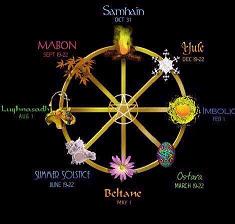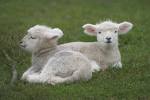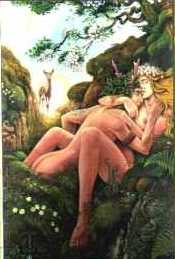|
The Wheel of the Year by Pat Carbonell
1. Yule - Winter solstice Dec. 20th or 21st [Summer Solstice] Winter Solstice is the shortest day of the year. Yule celebrates (or coerces, depending on the tradition) the return of the Sun, with hope for the end of winter. Imbolg is the first of the Spring festivals for fertility. Imbolg is the celebration of things yet to be born for the new year, and coincides with the lambing season. 3. Oestara - Vernal Equinox Mar. 20th or 21st [Autumnal Equinox] Oestara occurs in the middle of March when the length of day is equal to the length of night. It is a time of balance, the official end of winter and beginning of spring. The second of the fertility festivals, Oestara represents the seeding and preparation for the remainder of the year. 4. Beltaine May 1st or 5th [Nov. 1st] This holiday, the last of the spring fertility festivals, celebrates the time of love, and union. Specifically the union of the Lord and Lady, or the God/Goddess. In the oldest beliefs, the fertility of the land and the flocks/herds was promoted by the ritual intercourse of the High Priest and Priestess, representing the God and Goddess in the Great Rite... and then most everyone else grabbed a partner and headed for the bushes! Litha is the longest day of the year. The Midsummer festival celebrates the triumph of the Sun through the growing season, and is a festival of passion and glory. In the Celtic traditions it is also a celebration of the Mother Goddess who is seen heavy with child, ready to deliver the fruits of the season. 6. Lughnasadh Aug. 2nd or 7th [Feb. 2nd or 7th] The first of the harvest festivals, Lughnasadh, is the beginning of the harvest season, when the spring grains, early fruits and vegetables are ready to be picked. 7. Mabon - Autumnal Equinox Sept. 22nd or 23rd [Vernal Equinox] The second of the harvest festivals, this festival celebrates the gathering of the final crops of the fields and the fruits of the orchard. Samhain is the Pagan New Year, and completes the circle of the seasons. It is the last of the three harvest Sabbats, the blood harvest, the slaughtering of the culls from the flocks and herds. Because of the wealth of life energy released by the blood harvest, on the night of Samhain the veil between the spiritual world and the physical world is at it's thinnest. So there you are. I have a question, and hope that you, my readers, will answer in the comments: Would you like me to do a full discussion of the mythologies, rituals and connections to Christianity of each of the Sabbats when they are approaching? I don't want to bore people, but if the interest is out there, I'd be happy to do so. Blessed Be! |

|
Home||About FTTW||Disclaimer||
Advertise With Us||Links||
Submission Guidelines||Subscribe to Feed||Contact |
 With the festival of Beltaine just past, it seems to be an appropriate time to talk about the Pagan Wheel of the Year, or religious calendar. Beltaine is my favorite festival, even though I have yet to celebrate it properly... um, "properly" for my beliefs means fucking my brains out in a field with my magickal partner. I'll explain why later.
With the festival of Beltaine just past, it seems to be an appropriate time to talk about the Pagan Wheel of the Year, or religious calendar. Beltaine is my favorite festival, even though I have yet to celebrate it properly... um, "properly" for my beliefs means fucking my brains out in a field with my magickal partner. I'll explain why later. 2. Imbolg Feb. 1st or 2nd [August 1st]
2. Imbolg Feb. 1st or 2nd [August 1st] 5. Litha - Summer Solstice June 20th or 21st [Winter Soltice]
5. Litha - Summer Solstice June 20th or 21st [Winter Soltice]
Comments
Yes that's exactly the type of thing I hoped you'd write about.
Posted by: Dan | May 10, 2007 7:54 AM
Cool. I hope I haven't disappointed too many folks with the articles about my family and such... but things are settling in now, and I find I'm craving my witchy side ;-)
Posted by: Pat | May 10, 2007 6:03 PM
Lady, you could never bore anyone! It's hard to believe the Solistice is just around the corner!
Posted by: Jenn (A Lady Laments) | May 12, 2007 9:45 AM
I love when you talk about witch stuff. You seem happier when you do.
Although I would like to here the story about the other night when I got to miss out on three women working to put together a wedding dress for the youngest witch. ;D
Posted by: jo (from Amie & Dirty Laundry) | May 12, 2007 11:04 PM